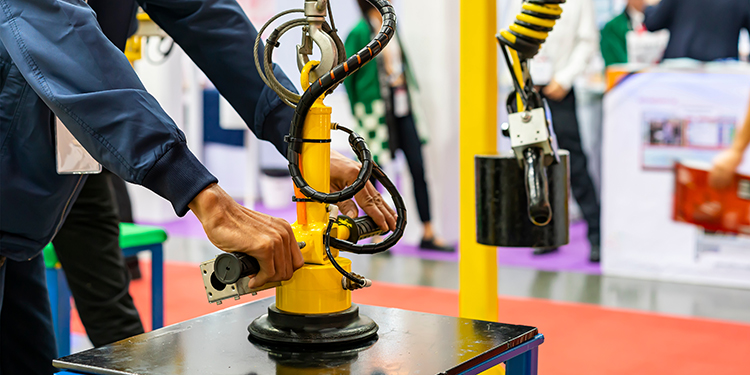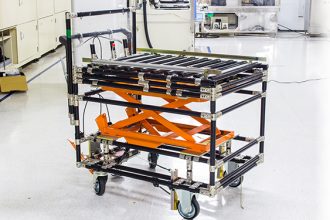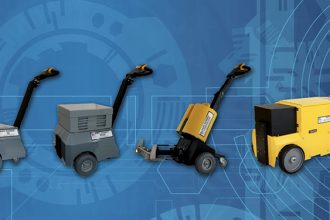Supercharge Ergonomics And Productivity With These Solutions

Improving workplace ergonomics is often associated with reducing the risk of injury for employees performing strenuous, repetitive, or awkward movements to do their jobs. However, improving ergonomics by fitting the work to the workers—regardless of their size, age, or physical abilities—often improves their efficiency and productivity as well. This enables the solutions to essentially pay for themselves!
By implementing systems and equipment that support five key ergonomic principles, companies can not only make tasks safer, but they can also boost throughput. Ergonomic solutions include those that:
1. Optimize Position. For a multi-shift, multi-operator facility utilizing work surfaces to perform tasks, a static workstation can force shorter users to stretch or reach excessively—such as above their shoulder—to access needed tools. This increases the risk of a strained back, arm, neck, or shoulder. Conversely, taller users may have to bend or hunch over awkwardly to do their work, potentially resulting in lower back or shoulder pain. By utilizing a height-adjustable workstation, each user can raise or lower the work surface to a level that provides an ideal vertical position.
Likewise, there are a variety of ergonomic accessories that can be added to a workstation that ensure the task at hand is presented in the optimal, neutral location. These include height-adjustable and articulating arms that support monitors and displays, keyboards, and label printers. That flexibility allows each worker to pull the devices closer or push them farther away to maximize their access, as well as raise or lower them for easy visibility and use. Such accessories also allow the needed tools to be suspended off of the worksurface—freeing up that real estate for the task at hand.
2. Eliminate Extreme Movements and Repetition. For employees manually and repeatedly pushing, pulling, lifting, holding, or carrying loads, several devices can significantly reduce the cumulative physical strain associated with these activities. Overhead lift systems such as workstation cranes, vacuum lifters, and intelligent lifting devices suspend a load from above and allow the operator to manipulate and position it as needed with minimal effort. Rotating lift tables and pallet positioners permit an employee to remain in one position while the table raises and lowers to keep the work at a convenient height, eliminating bending; an integrated turntable enables the work to be rotated closer, preventing stretching and reaching.
3. Minimize Forces. Typically applied to rolling carts and bins, easy rolling wheels and casters can reduce strain on the body by reducing the amount of manual force required to push or pull the load. Casters, capable of rotating 360-degrees so the wheel can travel in any direction, enable great maneuverability with little effort. Selecting harder tread materials—such as nylon, polypropylene, steel, or cast iron—with lower starting and rolling resistance travel more easily under a heavy load, reducing exertion. Further, powered wheels and casters eliminate virtually all physical effort to start or stop a loaded cart.
4. Organize and Color Code. For jobs that require use of multiple components to complete a process—such as an assembly task performed at a workstation—it’s important to organize each part into its own bin or container to reduce search time. Additionally, using different colors for each bin (for example, red for washers, green for screws, blue for nuts, yellow for bolts, and so on) and adding a label to the front that clearly and legibly identifies the contents can eliminate time spent looking for the right part. For further efficiency and minimal wasted movement, sequence the bins in the order in which each component it needed left to right, top to bottom, or in another arrangement that best aligns to the work at hand.
5. Improve Visibility. While some facilities may have windows or skylights that allow natural light into the workspace, nearly all need additional artificial lighting to help employees see their work. These include room lighting, overhead lighting, and focused task lighting that illuminates a specific work area for precise tasks. While eliminating shadows by brightening an area will reduce eye strain, it is important to not over-light an area; too much glare can also contribute to eye fatigue. Take steps to adjust the height, distance, and angle of each light source to ensure it isn’t shining directly into workers’ eyes. Additionally, magnifiers can be added for precision tasks such as assembly projects requiring fine tools and components. Monitors and screens should also be adjusted and calibrated with sufficient contrast, resolution, and brightness to minimize eye strain.
The aforementioned equipment examples are by no means the only solutions to each of these ergonomic challenges. As with many manual materials handling tasks there are often a variety of options that could be selected to lessen the risk of injury associated with a job while simultaneously increasing worker efficiency and productivity.
Need more help in assessing your operation’s ergonomic risks and how to best mitigate them? The members of the Ergonomic Assist Systems & Equipment (EASE) Council of MHI are always available to consult, answer questions and make recommendations. Learn more about EASE.



